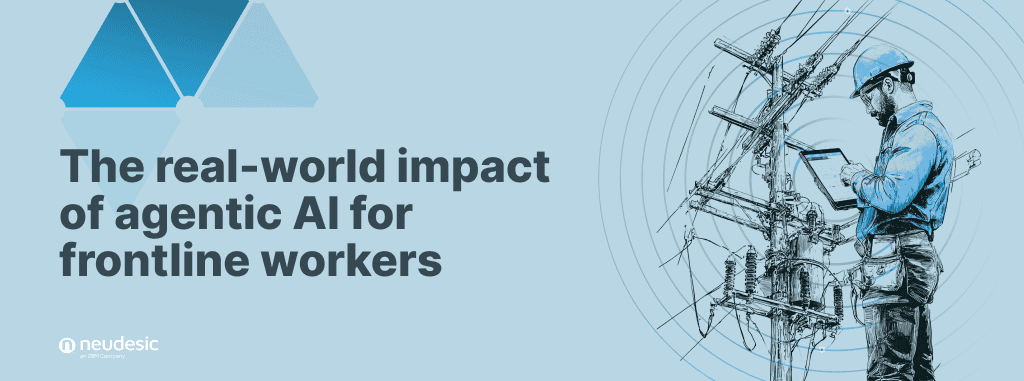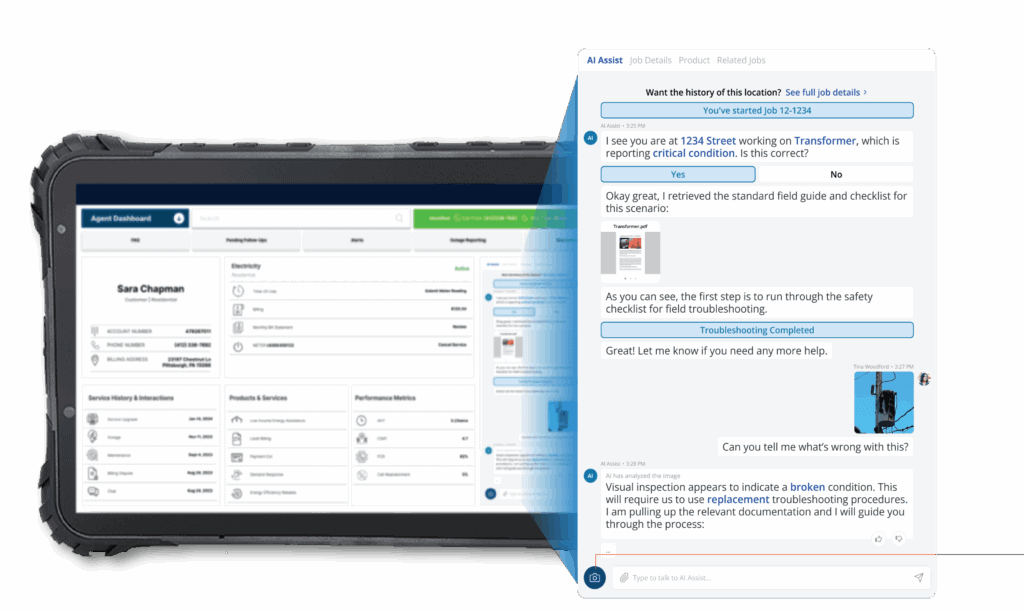
The utilities sector has been experiencing a growing disconnect between digital transformation strategies and the realities of field operations. In our first post, we took a closer look at how AI Field Assist, an agentic AI field service management solution, bridges that gap by delivering real-time, role-specific intelligence that empowers field staff, improves safety, and drives measurable business outcomes. Now, we’ll go deeper into what makes it different, how it works, real-world impact, and the measurable impact for utility leaders and field staff alike.
AI agent impact in field service management solution
Utility field service is inherently complex. Field personnel is expected to diagnose and repair increasingly sophisticated infrastructure often under pressure, in remote locations, and with limited access to real-time information. Traditional field mobility tools fall short in these moments. They’re fragmented, manual, and reactive.
AI Field Assist changes the game by embedding an AI agent directly into the technician’s workflow. Before a job even begins, the AI agent delivers a comprehensive, AI-curated briefing that is complete with asset history, location-specific risks, and required tools. Once on site, it provides step-by-step guidance tailored to the asset and environmental conditions, helping field staff troubleshoot with confidence and consistency.
A key differentiator: built on Microsoft
What makes AI Field Assist stand out is its foundation on Microsoft Azure and powered by the Retrieval-Augmented Generation (RAG) framework. This architecture combines the power of large language models with your organization’s own data—field manuals, SOPs, engineering diagrams, and historical job records—to deliver context-aware, accurate responses in real-time.
The AI agent doesn’t just answer questions: it reasons. It synthesizes information from multiple sources, understands the worker’s role and task, and delivers guidance that’s specific to the job at hand. It also integrates with core utility systems like GIS, SCADA, asset management, and work order platforms, ensuring that the AI agent for field staff is always working with the most current and relevant data.
This Microsoft foundation ensures enterprise-grade security, scalability, and compliance, while also enabling seamless integration with the tools utilities already use. Thus, AI Field Assist can be tailored to your workflows, your data, and your field service environment.
How AI agent works with the field staff
From preparation to inspection to documentation, AI simplifies complex tasks, reduces cognitive load, and empowers workers to work with confidence, clarity, and control. Here is how AI works with field techs from start to finish:
- Arrive fully prepared.
Before a job even begins, AI delivers a personalized, data-rich briefing that includes:
- Asset history and maintenance records
- Location-specific risks and environmental conditions
- Required tools, materials and safety protocols
This means field staff arrive on site with a clear plan and the right equipment, ready to get it right the first time.
- Access real-time troubleshooting and problem-solving.
Once on site, field personnel access direct AI assistance on the field that improves resolution rates through image capture and processing to assist with issue identification and voice–based interactions that streamline field engagement and reduce manual input.
It connects to IoT-enabled assets and uses real-time diagnostics to help pinpoint issues quickly and accurately. This results in:
- AI-powered troubleshooting narrows down root causes
- Live data from sensors enhances situational awareness
- Follow step-by-step guidance.
AI provides dynamic, context-aware instructions tailored to the asset and environment. Whether it’s a transformer diagnostic or a valve inspection, AI:
- Walks technicians through each step
- Flags safety checks and compliance requirements
- Prompts for required documentation
For newer field service technicians, this means faster onboarding and less reliance on senior staff. For experienced personnel, it’s a way to double-check procedures and reduce the risk of error.
- Spot hidden defects.
AI-enhanced image analysis supports visual inspections by detecting subtle issues that might be missed by the human eye including:
- Cracks, corrosion, and wear patterns
- Early signs of component failure
This proactive detection helps prevent future outages and costly repairs.
- Automate documentation.
As the job progresses, AI automates and organizes the reporting by capturing photos, notes, and readings to ensure accuracy and compliance such as:
- Photos, notes, and meter readings
- Auto-generated reports for compliance and audits
The result is less time spent on paperwork and more time focused on the work that matters.
- Accelerate learning and confidence.
AI acts as a digital mentor, helping new hires ramp up quickly while giving experienced technicians a reliable second opinion.
- Reduces reliance on senior staff
- Builds confidence in decision-making
- Supports continuous learning in the field
In short, AI for field service transforms every stage of the worker’s workflow, boosting efficiency, improving safety, and enabling better outcomes across the board.
Real-world use cases
To understand the impact of AI in field service, let’s take a closer look at how it performs in the context of real field scenarios, where time, safety, and precision matter most.
Scenario 1: Diagnosing a transformer in the field
A lineman arrives at a substation to investigate a transformer that’s been flagged for abnormal readings. Instead of flipping through a PDF manual or calling a supervisor, they simply ask, “What’s the diagnostic procedure for this model?” AI Field Assist immediately responds with the correct step-by-step process that is tailored to the specific asset, location, and job history. It even highlights recent maintenance logs and known failure patterns for that unit. The technician follows the guidance, identifies the issue, and completes the repair, all in one visit.
Scenario 2: Guiding a new gas tech through a valve inspection
A recently onboarded gas technician is assigned to inspect a high-pressure valve for the first time. Normally, this would require shadowing a senior field staff or calling in for support. But with AI Field Assist, the technician gets real-time, voice-guided instructions like, “Next, check the stem seal for corrosion. Here’s what to look for.” The Ai agent even prompts safety checks and confirms that each step is completed before moving on. The result? A confident, compliant inspection without pulling a veteran off another job.
Scenario 3: Responding to a storm outage
During a severe weather event, a crew is dispatched to restore power in a rural area. The conditions are unpredictable, and the asset data is incomplete. AI Field Assist helps the crew triage the situation by pulling in relevant outage history, surfacing the most likely failure points, and recommending the safest restoration sequence. It also provides instant access to emergency protocols and environmental safety guidelines based on the crew’s GPS location. In a high-pressure moment, the assistant becomes a critical source of clarity and control.
These are just a few examples of how AI Field Assist shows up in the field, not as a replacement for human expertise, but as a force multiplier. It helps crews move faster, make better decisions, and stay safer no matter the conditions.
Measurable business impact: for leaders and field workers
The value of leveraging AI in field service extends far beyond the worker’s tablet. It drives real business outcomes across safety, efficiency, and workforce performance. Utilities experience measurable impact for business leaders and field workers.
Agentic AI benefits for field workers
For field staff, AI Field Assist acts as a real-time partner in the field. Whether they’re new to the role or seasoned experts, field workers gain the support they need to work smarter, safer, and with greater confidence. Here’s how an AI agent transforms the field experience and delivers measurable results:
- 30% boosted field staff productivity output
Workers are solving more problems faster, which boosts productivity across the board.
- 16% enhanced first-time fix rate
With better preparation and real-time support, more jobs are completed correctly on the first visit.
- 34% improved work order speed
Streamlined workflows and instant insights are cutting resolution times dramatically.
- Up to 80% reduction in false truck rolls
Smarter dispatching is eliminating unnecessary site visits and saving time and fuel.
- Higher employee satisfaction and retention
Field teams feel more supported, empowered, and equipped to succeed.
What now?
From reducing operational costs and safety incidents to empowering technicians with real-time intelligence, AI agent for field staff is transforming how work gets done in the field. It bridges the gap between strategy and execution, enabling utility teams to respond faster, work smarter, and deliver better outcomes across the board.
Read on to our final post of this series to see how you can launch AI Field Assist fast and start driving impact in your field service in weeks. Learn more about AI Field Assist here.
Related Posts

